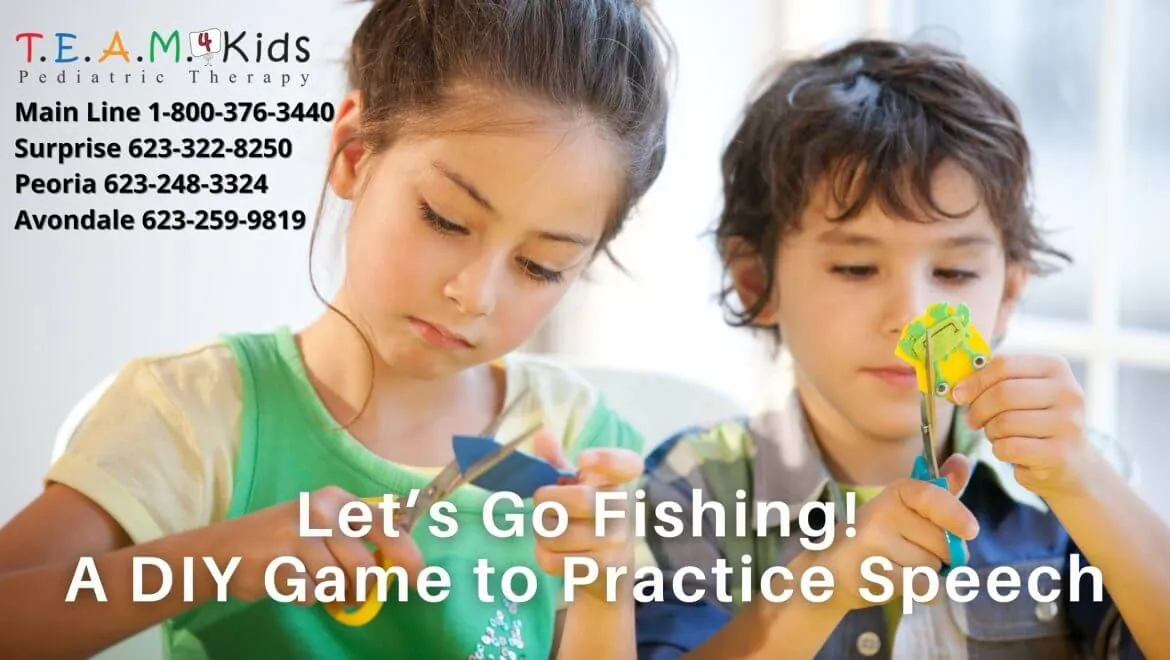Practicing speech and language skills at home can sometimes feel like a chore. Although there are an infinite amount of opportunities to naturally practice these skills during your daily routine, your child may additionally need a more structured practice. However, when it comes time to mindfully and deliberately working on specific skill sets, your kiddos may not share your same enthusiasm or you may feel overwhelmed at the possibilities of how to practice. I would like to share with you how to create a fun and interactive fishing game that can be personalized for your child’s speech and language needs. It’s important for children to enjoy themselves while practicing targeted skills so they will want to keep playing and have as many opportunities to practice as possible.
As a speech-language pathologist, I have created many personalized games for my clients. One of my favorite games to make, and a favorite to play, is called “Let’s Go Fishing!”.
This game can be used to practice speech sounds, receptive vocabulary, expressive vocabulary, fluency strategies, social skills such as taking turns, requesting, commenting, and much more! Playing is simple, and you can modify how you play depending on what you want to practice. You could get fancy and keep score with points, stickers, or no points at all. It can be played one on one or with the whole family.

Materials needed are:
Construction paper
Scissors
Pictures or photographs
Magazines and/or computer and printer
Paper clips
Glue or tape
String (anything you can tie around a magnet) about 2 feet
“Pole” (my favorite is a paint mixing stick, but other items like a stick, dowel, chopstick, etc are just as good)
Magnet (make sure it is strong enough to pick up the paperclip on the “fish”)
It’s fun to make:
1. First, find pictures that represent what you are practicing. For example, if you are practicing the /s/ sound in the initial position then maybe you cut out pictures from a magazine or print out pictures that show a sun, soup, sock, seal, soap, sick, sad. If you are practicing emotional vocabulary then you can cut out pictures that represent frustration, angry, boredom, tired, excited. You might want to print out pictures of friends and family, or of your child’s favorite toys. The possibilities are endless.
2. Second, cut out fish shapes using construction paper. The fish should be big enough to fit the magazine/printed pictures onto the fish. The fish can also be of different sizes (and you can practice size concepts, such as “big” and “little”, while you’re at it!).
3. Third, glue or tape the previously cut out pictures onto the fish
4. Fourth, place the paper clip onto the “fish”
5. Lastly, tie one end of the string to the “pole” and the other end of the string around a magnet

Some ways to play:
1. If your child is working on speech sounds, find pictures that represent the word containing the targeted sound. As your child catches a fish, she or he says the word and practices the speech sound. When collecting pictures for this task, try to be mindful of how long the word is (multisyllabic words may be more difficult than monosyllabic words) and the position of the sound within the word.
2. If your child is practicing identifying vocabulary words, then you, a sibling, or another player can tell your child which picture to fish for (e.g., “Clementine, fish for the socks!”)
3. To expand expressive vocabulary skills, each round can contain pictured items that belong to a specific category (e.g., clothing, food, colors, shapes, animals). Each time your child catches a fish, he or she can label the pictured item. Your child can also tell another player which picture to fish for by using the vocabulary of the pictured items.
4. If your child is working on using past tense verbs, you can write present tense verbs onto the fish or glue pictures of an action onto the fish. After your child catches the fish, she or he says the verb in the past tense.
5. If your child is practicing a fluency strategy, such as easy onset, everyone playing can say a phrase when it’s their turn to fish using the easy onset technique (e.g., “It’s my turn,” or “I caught…”).
6.Your child can practice expanding his or her utterance length by using a carrier phrase each time they catch a fish or right before they catch a fish (e.g., “I see a (descriptive word- red, small, happy, big, blue) fish”)
7. If your child is working on answering yes/no questions you can ask them a factual yes/no question (e.g., “Is it your turn?”, “Did you catch a ___?”). Don’t forget to ask them questions where the answer is “no” just as much as the answer is “yes”!
8. If your child is practicing answering wh- questions you can glue different occupations onto the fish or pictures of family members and ask “who” questions, or glue pictures of various places (e.g., a school, a doctor’s office) and ask “where” questions (e.g., “Where do you go to learn?”)
9. Your child can practice simple social skills by taking turns, making eye contact while requesting “My turn please”, or using social niceties such as “Good job!” when someone else catches a fish
10. Your child can practice more advanced social skills by fishing for a fish that has a conversation starter written on it (you can search “conversation starters for kids” or “conversation topics for kids” to get a variety of ideas). Some examples include “My favorite food is…”, “What superpower would you choose to have?”
Don’t forget, your child’s speech and language skills can be targeted while making this game too, not just while playing it! That alone can be an enriching and bonding experience that builds self-esteem as they experience their hard work turn into a game that is played and enjoyed!
If you have any questions regarding your child’s speech or language needs, T.E.A.M 4 Kids would love to help! Contact T.E.A.M 4 Kids at our Surprise, Peoria, or Avondale location.
 Ricki Abrams-Stern, M.S., CCC-SLP
Ricki Abrams-Stern, M.S., CCC-SLP

